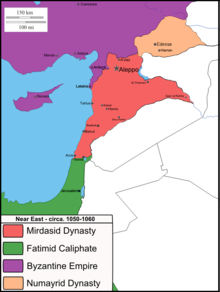Mirdasids
The Mirdasids ( Arabic مرداسيون) were a local Muslim dynasty and controlled the emirate of Aleppo almost entirely between 1024 and 1080.
The Mirdasid rulers were members of the Banu Kilab tribe who had settled in northern Syria for several centuries. Like the other Arab tribes in the region, the Mirdasids were Shiites and so were receptive to the propaganda of the Qarmatian sect , which denounced the wealth of the urban Sunnis . But with the later seizure of power by the Sunni Seljuks over the region, the Mirdasids under Raschid al-Daula Mahmud converted to Sunni Islam.
Unlike the Arab tribes in Syria, who focused on increasing their autonomy or independence, the Mirdasids were more anxious to develop Aleppo as a city. As a result, Aleppo flourished among the Mirdasids, who were more tolerant of Christian Syrians than the other Muslims. They favored Christian merchants in their area and even had Christian viziers at court. This and their good relations with the Byzantine Empire met with the resentment of the rest of the Muslims.
In the beginning the Mirdasids had to defend themselves against the strong pressure of the Byzantines and the Fatimids from Egypt. With a mix of diplomacy and military strength, they managed not to get worn out. The Mirdasid military consisted of light cavalry and fighters from neighboring tribes such as the Numairids of Harran . But when the Seljuks appeared as new opponents, it became clear that the Mirdasids had a harder time against their fighters. In contrast, the Mirdasids began to hire Turkish mercenaries, but this caused problems over time, as the Turks later rose to high positions.
Historical career
After the fall of the Hamdanids in 1004, Aleppo was ruled by vassals of the Fatimids. In 1024 the first Mirdaside Salih ibn Mirdas was able to drive out these vassals. He took the title Asad ud Daula and conquered an area from Baalbek via Homs , Aleppo, Manbidsch to ar-Raqqa and Qalʿat ar-Rahba deep in eastern Syria. Salih ibn Mirdas died five years later fighting the Fatimids. He was inherited by his sons Shibl al-Daula Nasr and Mu'izz al-Daula Thimal. Although Shibl al-Daula Nasr 1030 at Aʿzāz the Byzantines under Romanus III. suggested, he had to recognize their supremacy. But a short time later he switched to the Fatimids, who killed him in 1038 and took Aleppo. Nasr's brother Thimal took Aleppo back in 1042 and made peace with the Fatimids. Now he was a vassal of both the Byzantines and the Fatimids. Thimal was later dropped from his own tribe and replaced by his nephew Rashid al-Daula Mahmud in 1060. However, in 1061, Thimal came back and defeated his nephew, only to die the next year. Rashid al-Daula Mahmud and another brother of Thimal by the name of 'Atiyya ibn Salih were now fighting over the inheritance. This follow-up dispute split the country so that Rashid al-Daula Mahmud controlled the western half and 'Atiyya ibn Salih controlled the eastern half with Aleppo. In order to get the entire empire, 'Atiyya ibn Salih hired Turkish mercenaries, who betrayed him and betrayed him to his nephew Raschid al-Daula Mahmud. 'Atiyya ibn Salih had to give up Aleppo in 1065.
With the Seljuks, many Turkish settlers came to Syria, so that the Mirdasids became subjects of the Seljuks and converted to Sunniism. Through the rapid deaths of Raschid al-Daula Mahmud (1075) and his successor Jalal al-Daula Nasr (1076) Nasr's brother Sabiq ibn Mahmud became the new ruler. Conflicts within the Mirdasids and with various Turkish groups devastated the country, so that in 1080 the Uqailids conquered Aleppo. After the loss of Aleppo, the Mirdasids still had a relative influence and so fought against the First Crusade (1096-1099).
Emirs of the Mirdasids
- Salih ibn Mirdas, 1024-1029
- Shibl al-Daua Nasr, 1029-1038
- Mu'izz al-Daula Thimal, 1042-1057
- Raschid al-Daula Mahmud, 1060-1061
- Thimal, 1061-1062
- 'Atiyya ibn Salih, 1062-1065
- Mahmud ibn Nasr, 1065-1075
- Nasr ibn Mahmud, 1075-1076
- Sabiq ibn Mahmud, 1076-1080
Individual evidence
- ↑ Encyclopaedia of Islam, Volume VII (Mif-Naz) p. 115
literature
- Thierry Bianquis: Mirdas , article in The Encyclopaedia of Islam , New Edition, Volume VII: Mif-Naz, Verlag BRILL, Leiden and New York 1993, pp. 115-123
- Stefan Heidemann: The renaissance of the cities in northern Syria and northern Mesopotamia. Urban development and economic conditions in ar-Raqqa and Harran from the period of Bedouin domination to the Seljuks , published in Islamic History and Civilization. Studies and Texts 40, BRILL Verlag, Leiden 2002

